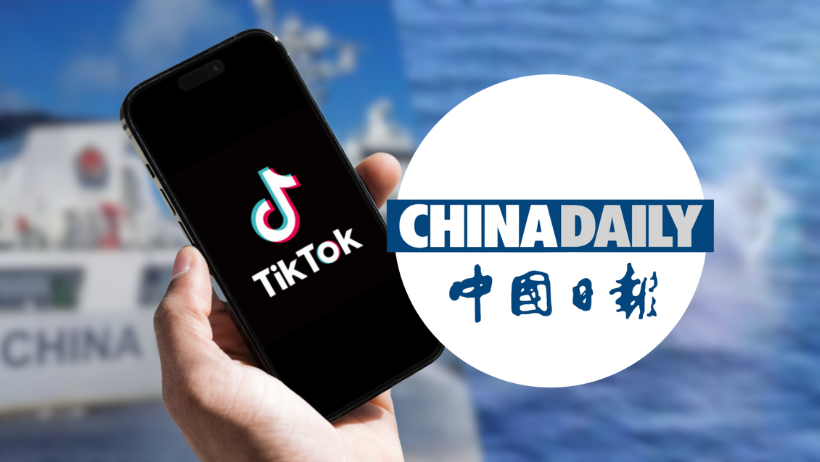#PHProtectProject

(Second of two parts)
…
China Daily’s Media Unlocked has been utilizing time-tested strategies to push pro-Beijing narratives to a new generation of audiences on TikTok.
One is by passing off as facts what are, upon examination, unfounded assertions, said Dr. Jonalou Labor, an associate professor at the University of the Philippines (UP) College of Mass Communication.
“These are examples of deceptive and propagandistic TikTok political posts that are meant to capitalize on political opinions more than facts,” Labor told PressOne.PH.
“Since the TikTok posts are framed to appear as facts even if these are just baseless opinions, they are meant to reach an audience who may be swayed to believe social media forms that appear as truth even if they are mere disinformation campaigns,” he added.
READ: IN-DEPTH: AI bolsters China state media’s TikTok offensive to influence narrative on sea dispute
Below is PressOne.PH’s sampling of Media Unlocked’s assertions on its TikTok videos that tackled the sea dispute between Manila and Beijing. For context, Media Unlocked was responding to Philippine media’s recent reporting of its pro-China social media content.
- “This all started because we posted videos explaining why the Philippines’ claims in the South China Sea don’t really hold up, both historically and legally.” (March 18, 2024)
- “We’ve looked into the accusations against us, and it turns out they’re just parroting the Philippine government’s talking points and even supporting a Redditor’s call for mass reporting of our videos.” (March 18, 2024)
- “It merely traps Filipinos in a nationalist bubble and pulls them into a U.S.-led crusade against free speech on TikTok.” (March 18, 2024)
- “In recent times, the Philippines has repeatedly dispatched ships and military vessels to intrude upon China’s Renai Reef and Huangyan Island, engaging in actions that provoke tension.” (March 11, 2024)
- “In contrast, our response has been to present objective information, emphasizing the relevant laws and historical context, and to offer a critical perspective on the Philippine media’s often unprofessional and biased portrayal of events in the South China Sea.” (March 11, 2024)
- “On March 5th, the Philippines broke their promise and sent vessels to the area near Ren’ai Reef in the South China Sea. They were there to deliver supplies to their military ship, which shouldn’t have been there.” (March 6, 2024)
- “We’ve received some pictures indicating interaction between Filipino fishery vessels and Philippine government vessels. Some people have questioned the authenticity of these fishermen.” (Feb. 27, 2024)
On March 26, Prof. Jay Batongbacal of the UP College of Law took to X (formerly Twitter) to again set the record straight on Ayungin Shoal, which Media Unlocked refers to as Ren’ai Reef.
“Ayungin (Second Thomas) Shoal is a submerged reef more than 1,138 km from China. The spurious and excessive nature of China’s claim to continuous sovereignty and jurisdiction ‘since ancient times’ is about as realistic as a Wuxia movie,” Batongbacal said.
The area near Ayungin Shoal has been the site of China’s repeated harassment of Filipino vessels engaged in humanitarian resupply missions to a submerged vessel, the BRP Sierra Madre.
On the argument that Manila failed to honor a supposed promise to remove BRP Sierra Madre from Ayungin, Batongbacal pointed out that “Beijing never honored its word that Mischief Reef was only a fishermen’s shelter and will remain for civilian purposes open to joint use in the future, officially promised by Wang Yi on 22-23 March 1999.”
In 2016, Manila won an international arbitration case that invalidated China’s claims to nearly the entire South China Sea, a ruling that Beijing refuses to recognize.
The Hague tribunal invalidated China’s nine-dash-line map that encroaches upon the Philippines’s 200-nautical-mile exclusive economic zone, which covers Ayungin Shoal and Mischief Reef.
The ruling also stated that China had unlawfully prevented Filipino fishermen from exercising their traditional fishing rights at Scarborough Shoal, which is well within the EEZ and appears in old maps as part of Philippine territory.
Media Unlocked refers to the shoal as Huangyan Island. The shoal has been heavily reclaimed by Beijing since it took over after the 2013 standoff that forced Manila to seek arbitration.
‘Attempt to establish credibility’
Another tactic employed by Media Unlocked is the use of news formats to lend its pro-Beijing narratives a veneer of legitimacy, said Labor, who is also the treasurer of the Philippines Communication Society.
“Framing the posts as news, since there are newsreaders in the posts, is an attempt to establish credibility as this form of visual narration is a familiar way to a majority of audiences,” Labor said.
Media Unlocked’s short videos are often polished productions that feature standuppers by China Daily anchors and interviews with academics and analysts.
An examination of Media Unlocked’s videos found no efforts to separate blatant editorializing from news or at least label them clearly, as the practice in many professional newsrooms.
In a Jan. 18, 2024 video reacting to President Ferdinand Marcos Jr.’s congratulatory message to the newly elected president of Taiwan, which Beijing considers a renegade province, China Daily reporter Meng Zhe remarked, “Even Bongbong’s sugar daddy said the US doesn’t support Taiwan independence,” as the video cut to an image of US President Joe Biden.
“Filipinos may have intended to provoke China. We are all aware of the South China Sea dispute,” he claimed.
Labor said there must be a stronger pushback against China’s propaganda campaigns.
“Such posts by the Chinese media should be a source of concern and be a basis for a stronger call to action to protect the Philippines from all baseless claims from the Chinese authorities,” said Labor. Felipe F. Salvosa II